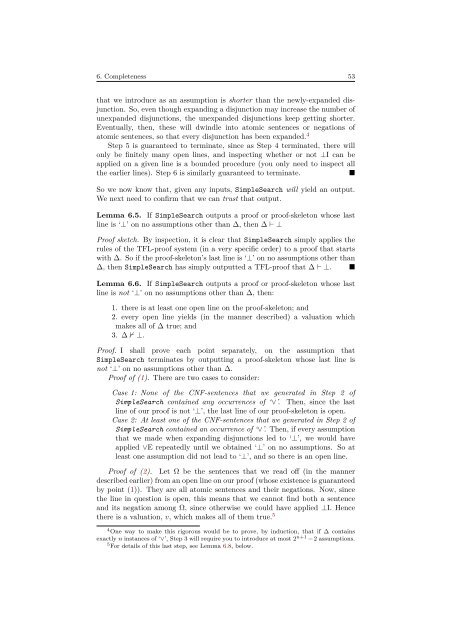Metatheory - University of Cambridge
Metatheory - University of Cambridge
Metatheory - University of Cambridge
You also want an ePaper? Increase the reach of your titles
YUMPU automatically turns print PDFs into web optimized ePapers that Google loves.
6. Completeness 53<br />
that we introduce as an assumption is shorter than the newly-expanded disjunction.<br />
So, even though expanding a disjunction may increase the number <strong>of</strong><br />
unexpanded disjunctions, the unexpanded disjunctions keep getting shorter.<br />
Eventually, then, these will dwindle into atomic sentences or negations <strong>of</strong><br />
atomic sentences, so that every disjunction has been expanded. 4<br />
Step 5 is guaranteed to terminate, since as Step 4 terminated, there will<br />
only be finitely many open lines, and inspecting whether or not ⊥I can be<br />
applied on a given line is a bounded procedure (you only need to inspect all<br />
the earlier lines). Step 6 is similarly guaranteed to terminate.<br />
■<br />
So we now know that, given any inputs, SimpleSearch will yield an output.<br />
We next need to confirm that we can trust that output.<br />
Lemma 6.5. If SimpleSearch outputs a pro<strong>of</strong> or pro<strong>of</strong>-skeleton whose last<br />
line is ‘⊥’ on no assumptions other than ∆, then ∆ ⊢ ⊥<br />
Pro<strong>of</strong> sketch. By inspection, it is clear that SimpleSearch simply applies the<br />
rules <strong>of</strong> the TFL-pro<strong>of</strong> system (in a very specific order) to a pro<strong>of</strong> that starts<br />
with ∆. So if the pro<strong>of</strong>-skeleton’s last line is ‘⊥’ on no assumptions other than<br />
∆, then SimpleSearch has simply outputted a TFL-pro<strong>of</strong> that ∆ ⊢ ⊥. ■<br />
Lemma 6.6. If SimpleSearch outputs a pro<strong>of</strong> or pro<strong>of</strong>-skeleton whose last<br />
line is not ‘⊥’ on no assumptions other than ∆, then:<br />
1. there is at least one open line on the pro<strong>of</strong>-skeleton; and<br />
2. every open line yields (in the manner described) a valuation which<br />
makes all <strong>of</strong> ∆ true; and<br />
3. ∆ ⊬ ⊥.<br />
Pro<strong>of</strong>. I shall prove each point separately, on the assumption that<br />
SimpleSearch terminates by outputting a pro<strong>of</strong>-skeleton whose last line is<br />
not ‘⊥’ on no assumptions other than ∆.<br />
Pro<strong>of</strong> <strong>of</strong> (1). There are two cases to consider:<br />
Case 1: None <strong>of</strong> the CNF-sentences that we generated in Step 2 <strong>of</strong><br />
SimpleSearch contained any occurrences <strong>of</strong> ‘∨’. Then, since the last<br />
line <strong>of</strong> our pro<strong>of</strong> is not ‘⊥’, the last line <strong>of</strong> our pro<strong>of</strong>-skeleton is open.<br />
Case 2: At least one <strong>of</strong> the CNF-sentences that we generated in Step 2 <strong>of</strong><br />
SimpleSearch contained an occurrence <strong>of</strong> ‘∨’. Then, if every assumption<br />
that we made when expanding disjunctions led to ‘⊥’, we would have<br />
applied ∨E repeatedly until we obtained ‘⊥’ on no assumptions. So at<br />
least one assumption did not lead to ‘⊥’, and so there is an open line.<br />
Pro<strong>of</strong> <strong>of</strong> (2). Let Ω be the sentences that we read <strong>of</strong>f (in the manner<br />
described earlier) from an open line on our pro<strong>of</strong> (whose existence is guaranteed<br />
by point (1)). They are all atomic sentences and their negations. Now, since<br />
the line in question is open, this means that we cannot find both a sentence<br />
and its negation among Ω, since otherwise we could have applied ⊥I. Hence<br />
there is a valuation, v, which makes all <strong>of</strong> them true. 5<br />
4 One way to make this rigorous would be to prove, by induction, that if ∆ contains<br />
exactly n instances <strong>of</strong> ‘∨’, Step 3 will require you to introduce at most 2 n+1 − 2 assumptions.<br />
5 For details <strong>of</strong> this last step, see Lemma 6.8, below.
















